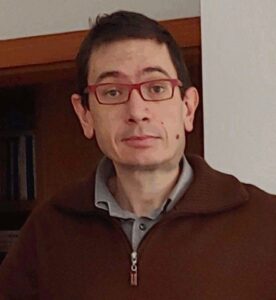
- General Information
- Symposia
- Atomic Layer Deposition
- Biomaterials and polymers
- Characterizacion and metrology
- Luminescence Phenomena
- Microelectronics and MEMS
- Nanostructures
- Plasma and Vacuum
- Renewable Energy: Materials and Devices
- Semiconductors
- Tribology, Surface and Interfaces
- Theory and Simulation of Materials
- Thin Films
- Science Outreach
- Plenary Lectures
- Short Courses
- Book of Abstracts
- General Program
- Agenda
- Poster Session
- Oral Session
- Congress Registration
- Abstract Submission
- Committees
- Fees
- Awards/Grants
- Athletic race 2025
- Sponsors and exhibit
- Hotel Accomodation
Flexible glass planar structures fabricated by rf-sputtering

Alessandro Chiasera
1IFN-CNR, CSMFO Lab and FBK Photonics Unit, Trento;
*alessandro.chiasera@cnr.it
Alessandro Chiasera received the Ph.D. degree in physics in 2003. He is currently a Researcher at the CNR of Italy, Institute for Photonics and Nanotechnologies IFN, Unit of Trento, Italy. Since 2000, his principal activity is related to the develop and diagnostic of photonic devices based on glasses matrix fabricated by various techniques and, in particular, rf-sputtering. This research activity is related to the activities of the CSMFO Laboratory and the principal research activities, are: Properties, structure and processing of glasses and films for photonic applications and modelling and interpretation of the related physicals phenomena. Fabrication and optical, structural and spectroscopic characterization of optical planar waveguides obtained with various techniques (dip-coating, spin-coating, rf-sputtering, ion-exchange) activated with rare earth ions. Nanostructured and composite materials as example with co-activation with metal nanoparticles (massive systems, films, planar waveguides, ultra-transparent glass-ceramics). Fabrication with sol-gel route and rf-sputtering technique and optical, structural and spectroscopic characterization of 1D photonic crystal and artificial opals. He is involved in various national and international projects regarding glass photonics. He has 343 articles on International scientific journal and 305 communications in national and International conferences. His H-index is 37.
Abstract
The benefits in terms of cost efficiency and versatility achieved through the development of flexible and stretchable electronics and optoelectronics, in contrast to rigid systems, have greatly fueled the exploration of flexible photonic technologies. Introducing mechanical flexibility to photonic structures enables novel functionalities, further broadening their already extensive range of applications. Alongside advancements in flexible photonics based on organic platforms, an emerging approach is gaining attention, emphasizing the use of inorganic, all-glass ultra-thin structures. For oxide-based materials, their intrinsic properties, such as transparency, high thermal resistance, and chemical stability, can be harnessed within appropriate systems.
In this study, we present flexible SiO2/HfO2 one-dimensional photonic crystals and Er3+-doped flexible planar waveguide, fabricated via radio frequency sputtering. The photonic crystals exhibit a pronounced dependence of their optical properties on the angle of light incidence, particularly demonstrating a blue-shift of the stopband and a narrowing of the reflectance window. However, the most remarkable finding lies in the experimental evidence showing that even after breakage, with visible cracks forming in the flexible glass, the multilayer structures largely retain their integrity. The waveguiding system, deposited on ultrathin flexible glass substrate, showed an attenuation coefficient lower than 0.2 dB/cm at 1.54 μm and exhibits emission in the NIR region. This positions them as promising candidates for flexible photonic applications due to their robust optical, thermal, and mechanical stability. [1,2].
This research is supported by the projects: “nuovi Concetti, mAteriali e tecnologie per l’iNtegrazione del fotoVoltAico negli edifici in uno scenario di generazione diffuSa” CANVAS, LEMAQUME-QuantERA, Project PNRR “Nano Foundries and Fine Analysis – Digital Infrasctructure (NFFA-DI)” IR0000015, PRIN 2022 PNRR P2022YM8J3 “NANOscale nondestructive spectroscopic mapping of defectS in heterojunction dEvicES – NANOSEES”, HORIZON-TMA-MSCA-DN Met2Adapt “A European Doctoral network on Advanced Meta-materials and Meta-Structures for Adaptable, Resilient and Sustainable renewable energy power plants.”
[1] G. Zanetti, A. Carlotto, T.N.L. Tran, A. Szczurek, B. Babiarczuk, O. Sayginer, S. Varas, A. Vinante, J. Krzak, O.S. Bursi, D. Zonta, A. Lukowiak, G.C. Righini, V.M. Sglavo, M. Bonomo, S. Galliano, C. Barolo, S.M. Pietralunga, A. Chiasera, “1D photonic crystals fabricated by RF sputtering”, Proceedings SPIE 13003 (2024) pp. 130030R-1/12, Fiber Lasers and Glass Photonics: Materials through Applications IV, doi: 10.1117/12.3025887.
[2] A. Carlotto, T.N.L. Tran, B. Babiarczuk, N. Bazzanella, A. Szczurek, S. Varas, J. Krzak, O.S. Bursi, D. Zonta, A. Łukowiak, G.C. Righini, M. Ferrari, S.M. Pietralunga, A. Chiasera, “Low losses Er3+-doped flexible planar waveguide: Toward an all-glass flexible planar photonic system”, Ceramics International 49 (2023) pp. 41217-41221, ISSN: 0272-8842, doi: 10.1016/j.ceramint.2023.03.012.
Keywords: Flexible Glasses, RF-Sputtering, SiO2/HfO2 1D photonic crystals, planar waveguides, Optical Properties
Congress Registration
Early Bird Payment
August 31, 2025
Abstract Submission
Abstract submission deadline
June 22, 2025
Key Dates
Abstract Submision Deadline:
June 22, 2025
Intercovamex Award Best PhD and Master´s Thesis:
August 31, 2025
Student grant application deadline:
July 4, 2025
Franscisco Mejia Lira Award:
August 31, 2025
Early Bird payment:
August 31, 2025
